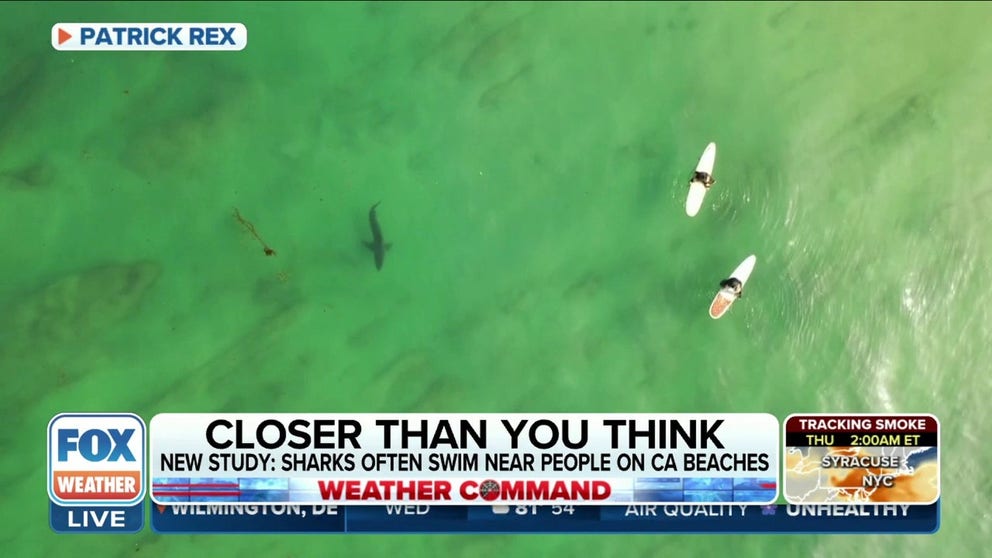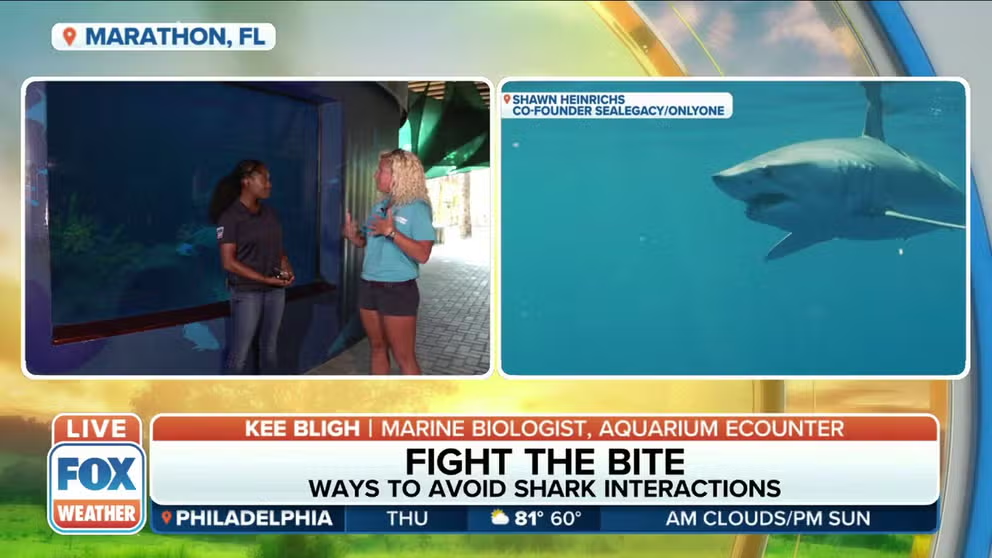How often are sharks along California's coast spotted near swimmers? More than you’d think
The study's findings can hopefully be used by California lifeguard programs to keep swimmers safe
New study shows swimmers are having close encounters with sharks along California coast
California State University Long Beach Shark Lab director Dr. Chris Lowe joined FOX Weather on Wednesday to discuss a new study that shows great white sharks are swimming closer to swimmers without them realizing what is lurking beneath the surface of the water.
LONG BEACH, Calif. – Groundbreaking research released last week shows how often sharks have been spotted swimming near beachgoers in California who have no idea what’s lurking in the water beneath them – and it’s way more often than you’d think.
Aerial surveys were conducted by California State University Long Beach (CSULB) graduate student Patrick Rex every month over a period of 2 years along several Southern California beaches from Santa Barbara to San Diego between January 2019 through March 2021.
GROUNDBREAKING RESEARCH SHOWS GREAT WHITE SHARKS MAY CHANGE COLOR TO BETTER HUNT THEIR PREY
Juvenile white sharks (JWS) utilize the populated Southern California beaches as a nursery habitat and have a high co-occurrence with people.
And the research findings showed that sharks and people were found swimming together in the water 97% of the time – and most swimmers had no idea, according to the study.
"Most (people) can’t see the sharks when they are at water level, but the drone picks them out quite well," said Dr. Chris Lowe, an author of the study and the director of the Shark Lab at CSULB.
NEW SHARK-SAVING TECHNOLOGY AIMS TO PROTECT SPECIES' MOST VULNERABLE HABITATS
Ways to avoid being bitten by sharks while at the beach
FOX Weather multimedia journalist Brandy Campbell was at Aquarium Encounters and spoke with Marine Biologist Kee Bligh about ways to avoid being bitten by a shark.
What's even more interesting is that during that staggering 97% statistic of nearby sharks to swimmers, the number of unprovoked shark bites in that region is "extremely low."
So low, that over the two-year survey period, only one minor potential unprovoked shark bite was reported across Southern California at one of the aggregation sites.
According to the study, the incident was reported in the spring of 2020 when a female swimmer said a marine animal bit her and saw a JWS leaving the area. However, the injury couldn’t be confidently identified as being caused by a JWS.
FLORIDA SHARK MATERNITY WARD MAY HAVE BEEN FOREVER CHANGED AFTER DIRECT HIT BY HURRICANE IAN
‘If we leave them alone, they leave us alone’
How surfers can avoid adverse shark encounters
Surfing expert Joe Appert joined FOX Weather to discuss whether shark-repellent wetsuits can prevent attacks.
Lowe said he hopes this new study will change how people think about sharks and has already noticed people have started to do so.
"We’ve already noted changes in attitudes by many local surfers who know the sharks are there and watch for them," he said. "Some have even become quite protective of the sharks."
Lowe added that the main concern is that people will try to see or film the sharks, which could lead to injuries.
STAY SHARK SMART: WHAT TO KNOW WHEN YOU HEAD INTO THE WATER
"Chasing them around could change their behavior and make them more defensive," he said. Lowe continued that this new information shows sharks aren’t out to attack humans.
"This study really dispels that myth that if a white shark I nearby, it will bite you," he said. "We found that at these shark nurseries, sharks and people are sharing waves every single day without incident."
'Tiger shark rammed me': Tiger shark attacks kayaker off Hawaii coast
A tiger shark rammed and bit a fisherman’s kayak off Hawaii’s Oahu island on Friday, May 12. Video recorded by Scott Haraguchi shows the animal charge at him and bite his kayak. Haraguchi then kicks the shark away.
Lowe added that maybe the recovery of the white shark population near the area is a good thing and a sign that the coastal waters are getting healthier for sharks to thrive. "Our study shows that if we leave them alone, they leave us alone."
And this study is also being used to keep people safe when enjoying the water. California lifeguard agencies can hopefully adopt the findings to monitor beaches for shark activity.
The study says the New South Wales territory in Australia developed a Shark Smart program that similarly surveys local beaches to identify shark hotspots at local beaches.



